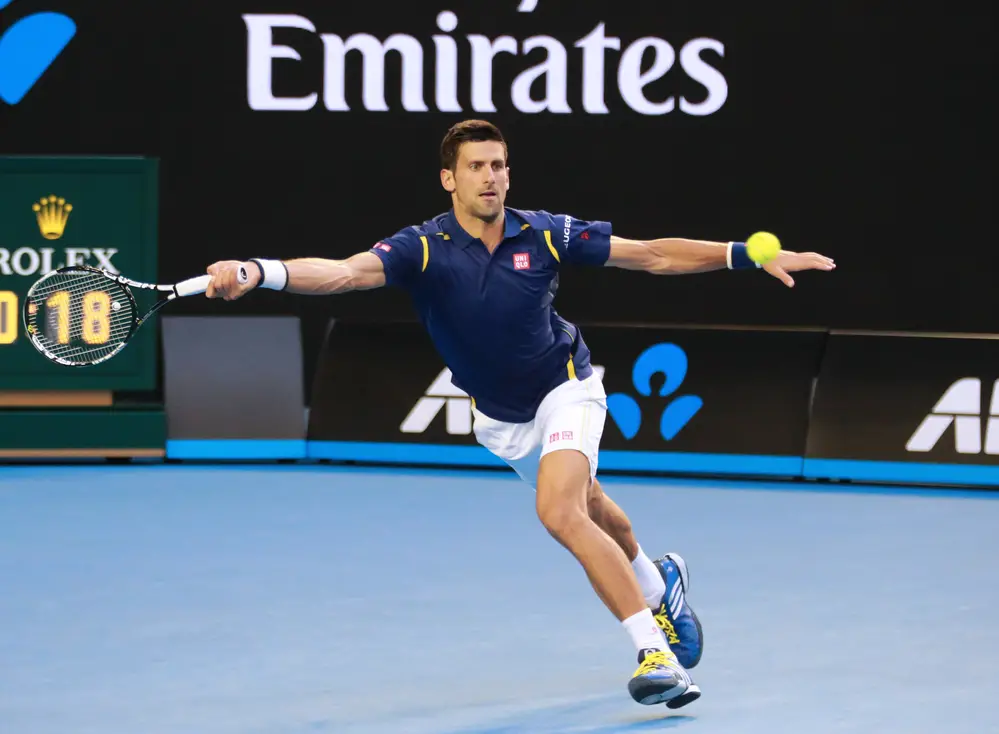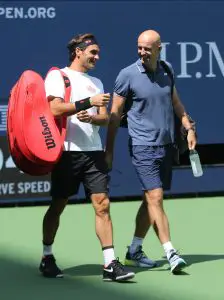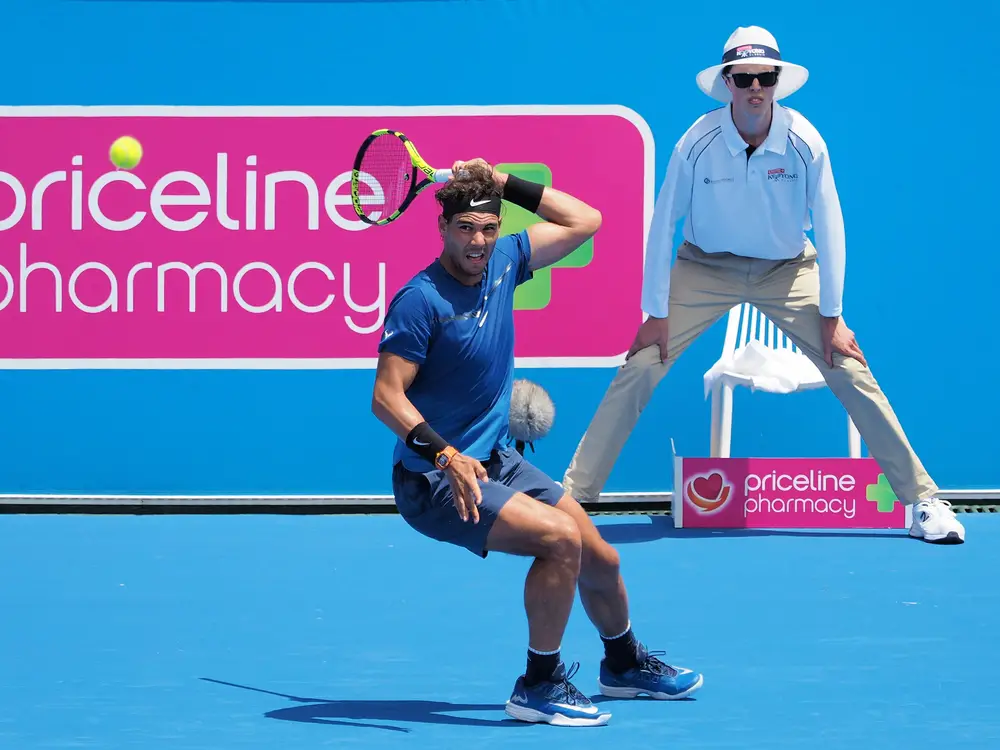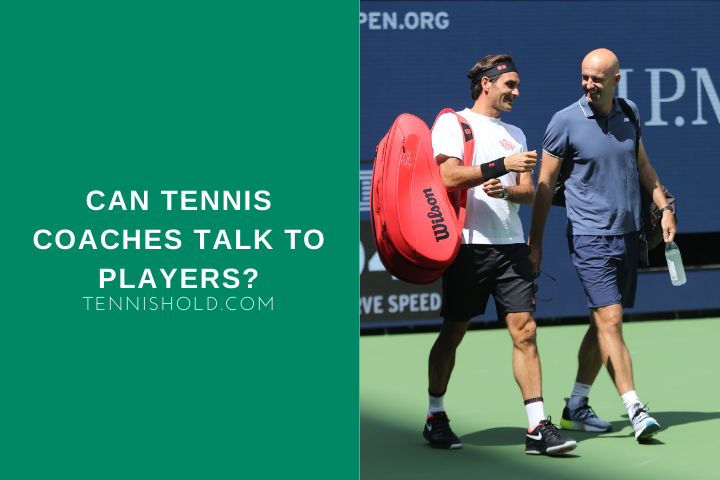Seeing a coach shouting at players giving instructions from the sidelines is common in soccer matches.
You do not see this in tennis as often, especially on the ATP world tour. The ATP world tour is the top tier of professional tennis for men.
At top events for women, you will see the coach occasionally on-court talking with them but not always.
Why is this so?
Are coaches allowed to talk to their players in the middle of a match?
The regulations depend on the event and the governing body regulating it. The ATP forbids coaching for players during matches. The WTA allows players to call their coaches on the court once per set. It is not permitted at grand slams for men or women.
The WTA (Women’s tennis association) is the governing body for the top level of women’s professional tennis.
Because the ATP forbids it and the WTA has no authority at men’s events, men cannot receive any coaching, except at the Davis cup, which has separate rules.
In this article I will be covering:
- The rules of on-court coaching
- Why some players are not allowed to talk to coaches on-court
- The punishments given for breaching the coaching rule
I hope you stick around; I will be sharing lots of interesting information.
What Are The Tennis On-Court Coaching Rules?

There is only one instance in which men who compete at the top tier of men’s tennis can get on-court coaching.
That is when representing their country in Davis Cup matches. If you are wondering, the Davis cup can be described as the closest thing to the world cup of tennis.
The reason players can receive coaching in Davis Cup events is that it is not regulated by the ATP. Instead, the Davis Cup is regulated by the ITF, International Tennis Federation.
Let’s be honest, tennis isn’t the simplest of sports regarding the number of governing bodies.
In Davis Cup events, coaching is always allowed, not just once per set. So when players change ends, they can sit down and chat with their coach.
The women’s version of the Davis Cup is known as the Billie Jean King Cup, and before 2020 it was known as the Fed Cup.
Women on the WTA tour are used to having on-court coaching once per set. When playing the Billie Jean King Cup, they also get to have their team captain on the court for coaching the entire time.
In grand slam events, the rules are slightly different. The Australian Open, Rolland Garros, Wimbledon, and the US Open make up the 4 grand slam tournaments. They enjoy special privileges that standard ATP/WTA events don’t.
Among these privileges is the ability to pick their own scoring system and set their own rules for on-court coaching.
As of 2021, all four of the grand slams ban on-court coaching. This goes for both women and men.
The grand slam rulebook forbids coaching both during the match and warm-up. It states that any audible or visible communication between a player and coach can be interpreted as coaching.
Related: Do Tennis Coaches Take Percentage Of Winnings?
Why Can’t Tennis Players Talk To Coaches On-Court?

Tennis is unique in the sense that it doesn’t have one universal rule regarding on-court coaching.
I will discuss why it is allowed at Davis/ Billie Jean King Cup events without any restrictions.
If you only watch tennis once per year when Wimbledon is on, you may be under the impression that tennis is a silent sport. One in which spectators quietly observe the point and then clap after its completion.
This is not the case at Davis Cup events. Instead, they are filled with noise, cheering, and in some cases, vuvuzelas.
At Davis/ Billie Jean King Cup matches, the player(s) are not representing themselves. Instead, they are representing their country.
As the captain is a part of the team, it would be strange not to be involved in the match itself. Therefore it is allowed at these events.
All top-level tennis players will have a team behind them. But, when Djokovic won Wimbledon 2021 and received his £1,700,000 paycheck, it was made out to him and him alone.
The theory behind the on-court coaching ban is that it is for the player alone to work out how to win as an individual sport.
Tennis is one of the most mental sports there is, and input from the coach could change the momentum within the match.
How often do you see players losing, go to the toilet and come out and completely turn the match around?
By not having on-court coaching it preserves the tradition of watching one man out on his own fighting for victory.
What Are The Violation Penalties?

As you’ve probably learned by now, the rules are different depending on where you are playing. Therefore, as the rules change, so can the penalties.
The grand slam rulebook stipulates that a player can receive a fine of up to $20,000 every time they break the coaching rules.
The grand slam rules go further, stating that players can be held accountable for the behavior of their coaches at the venue.
One example is a coach using audible obscenities on the premises of the grand slam venue.
It also allows for players to be punished if their coach is verbally abusive to any spectator, opponent, or member staff at the tournament site.
If a breach of the coaching rules occurs during a match, a player will be punished in accordance with the Point Penalty Schedule.
The Point Penalty Schedule is a three-stage system that punishes players for code violations.
The first breach will carry just a warning to the player. On the second offense, the player will lose a point.
The player will lose a game for the third and any subsequent breaches.
After the third offense, the referee and the Grand Slam Chief of Supervisors can determine whether the violation constitutes a default.
Default means the player loses the match, and victory is automatically awarded to the opponent.
The Point Penalty Schedule is also used in WTA and ATP events. Coaching will not carry a penalty on the WTA tour under the “coaching once per set” rule.
One of the most infamous coaching cases being penalized occurred in the 2018 US Open final.
Patrick Mouratoglou, coach of Serena Williams, made a hand gesture to her mid-match. Umpire Carlos Ramos spotted this who then gave Serena a code violation.
Serena’s first code violation in the match; she only received a warning. Serena was less than pleased with this.
She then proceeded to argue with Ramos and later smashed her racket. This, as the second offense, carried a point penalty.
After receiving the point penalty, she argued with Ramos, calling him a thief. As a result, Ramos gave her a third code violation, resulting in a game penalty.
Final Words
If you’re playing at amateur-level events, you should check the regulations with your governing body for whether coaching is allowed.
For players in the US, this would be the USTA. United States Tennis Association.
I don’t think the restrictions for on-court coaching are something we will see a change anytime soon. Especially not on the ATP tour.
What do you think of the rules? Would tennis be more exciting if there were no restrictions on coaching? But, on the other hand, perhaps you like the rules as they are.

